No end in sight for the UK’s Indian slump
“Unless there is a significant shift in UK visa policy or a re-introduction of Post Study Work, it is hard to see how the UK can recover its share of Indian students”
Aaron Porter, director of insights at Hotcourses, delves into the data…
Prime Minister Theresa May finished her first major international visit to India last week, and higher education was high on the agenda for the bilateral talks. Accompanied by Universities Minister Jo Johnson and a number of UK vice chancellors, attempts will surely have been made to arrest the slump in demand from Indian students looking at UK universities. Indian Premier Narandra Modi certainly raised the importance of ensuring the UK was both open and welcoming for Indian students.
Across the Hotcourses sites, which account for over 32,000,000 visits from prospective international students researching future study each year we have seen an alarming decline in interest from India looking at the UK, mirroring the slump in applications and enrolments in recent years. The removal of the Post Study Work entitlement, and a number of high profile stories which appear to show the UK is less welcoming have had great traction on the front pages of major Indian newspapers, and have clearly had an impact, whilst the UK’s competitors have simultaneously taken steps to make themselves more appealing.
“Attempts will surely have been made to arrest the slump in demand from Indian students looking at UK universities”
Our latest insight data for 2015/16 shows that the UK has slipped to the 3rd most popular destination for Indian students (behind the United States and Australia).
Searches from India (1 November 2014 – 31 October 2015):
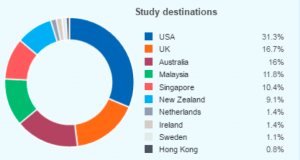
Searches from India (1 November 2015 – 31 October 2016):
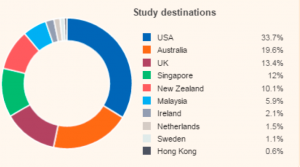
When comparing 14/15 vs 15/16 data, the picture is compelling and depressing for the UK. Market share falls from 16.7% to 13.4%, whilst the USA, Australia, New Zealand and Singapore have all grown theirs.
Charting the decline quarter by quarter
In a basket comparing the UK, with just the US, Australia and New Zealand it’s clear to see the gradual decline of Indian interest in the UK.
| Nov 14 – Jan 15 | Feb 15 – Apr 15 | May 15 – Jul 15 | Aug 15 – Oct 15 | Nov 15 – Jan 16 | Feb 16 – Apr 16 | May 16 – Jul 16 | Aug 16 – Oct 16
|
|
| USA | 40.8 | 39.0 | 43.7 | 45.9 | 47.5 | 41.2 | 44.6 | 43.6 |
| UK | 27.0 | 29.5 | 22.5 | 18.4 | 16.7 | 19.5 | 17.1 | 16.9 |
| Australia | 22.1 | 20.8 | 21.3 | 21.2 | 24.0 | 26.4 | 24.8 | 26.3 |
| NZ | 10.0 | 10.6 | 12.5 | 14.5 | 11.8 | 12.9 | 13.6 | 13.2 |
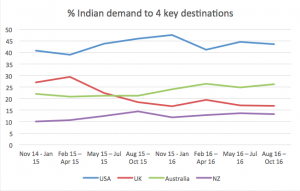
Is there any silver lining?
Drilling into a little more data for Indian students looking at the UK, there may be some slight consolation. When you delve into the Indian regions it appears that the majority of the slump has been concentrated in the Delhi and Maharashtra regions of the country. And perhaps surprisingly there have been modest increases in the share of searches from other regions such as Tamil Nadu and Kamataka.
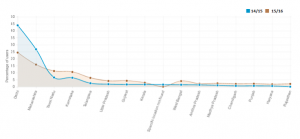
How does the subject mix differ?
Global subject searches from India / UK subject searches from India
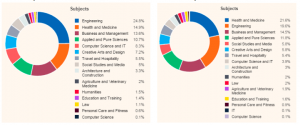
When looking at global universities, Indian students are most likely to be searching for engineering courses which accounts for 24.8%. With Engineering, Health and Medicine, and Business and Management making up the top 3. For searches to the UK, the top 3 is the same, however Health and Medicine is the singularly most researched subject area.
What next?
Bluntly, unless there is a significant shift in UK visa policy and/or a re-introduction of the Post Study Work entitlement, it is hard to see how the UK can recover its share of interest and enrolment of Indian students. We can say we are ‘open for business’ as much as we like, but actions speak louder than words. And the US, Canada and Australia are acting and winning market share.
For UK universities, we know that many of them are looking to diversify the base of their international recruitment. Of course, India remains important and taking a smarter approach to better convert interest is clearly crucial. An understanding of which regions and subjects are proving resilient is important, and insight and data can help inform that approach.
The data from this blog was drawn from the Hotcourses International Insights Tool which allows users to download data from over 32,000,000 global prospective students per year, dating back to November 2014. For more information or to access the tool, contact insights@hotcourses.com
Leave a Reply